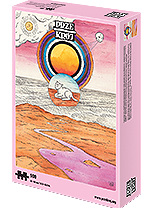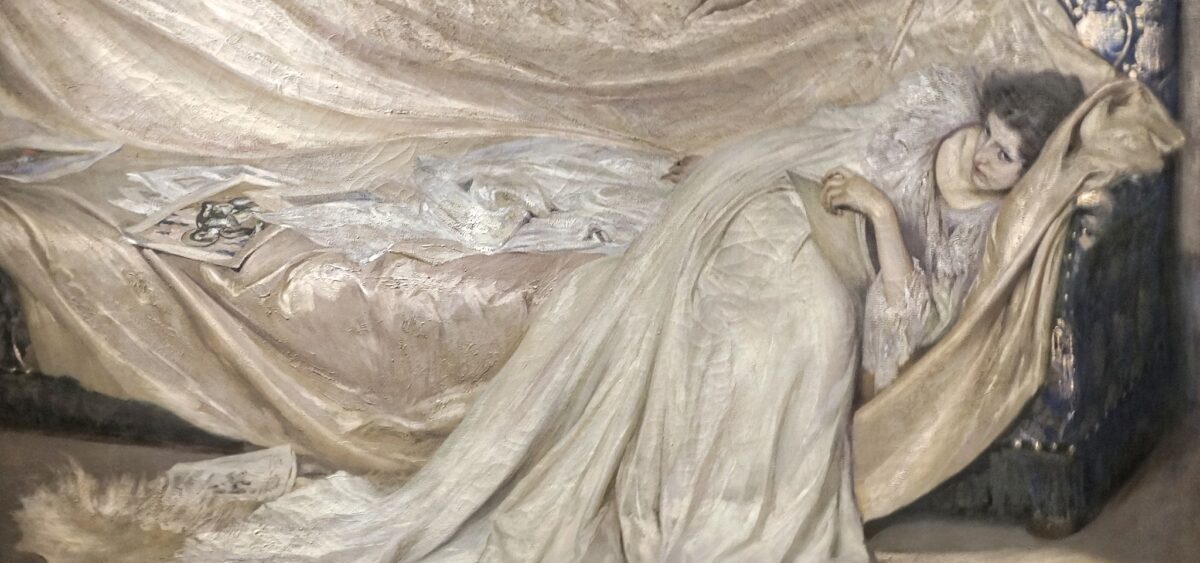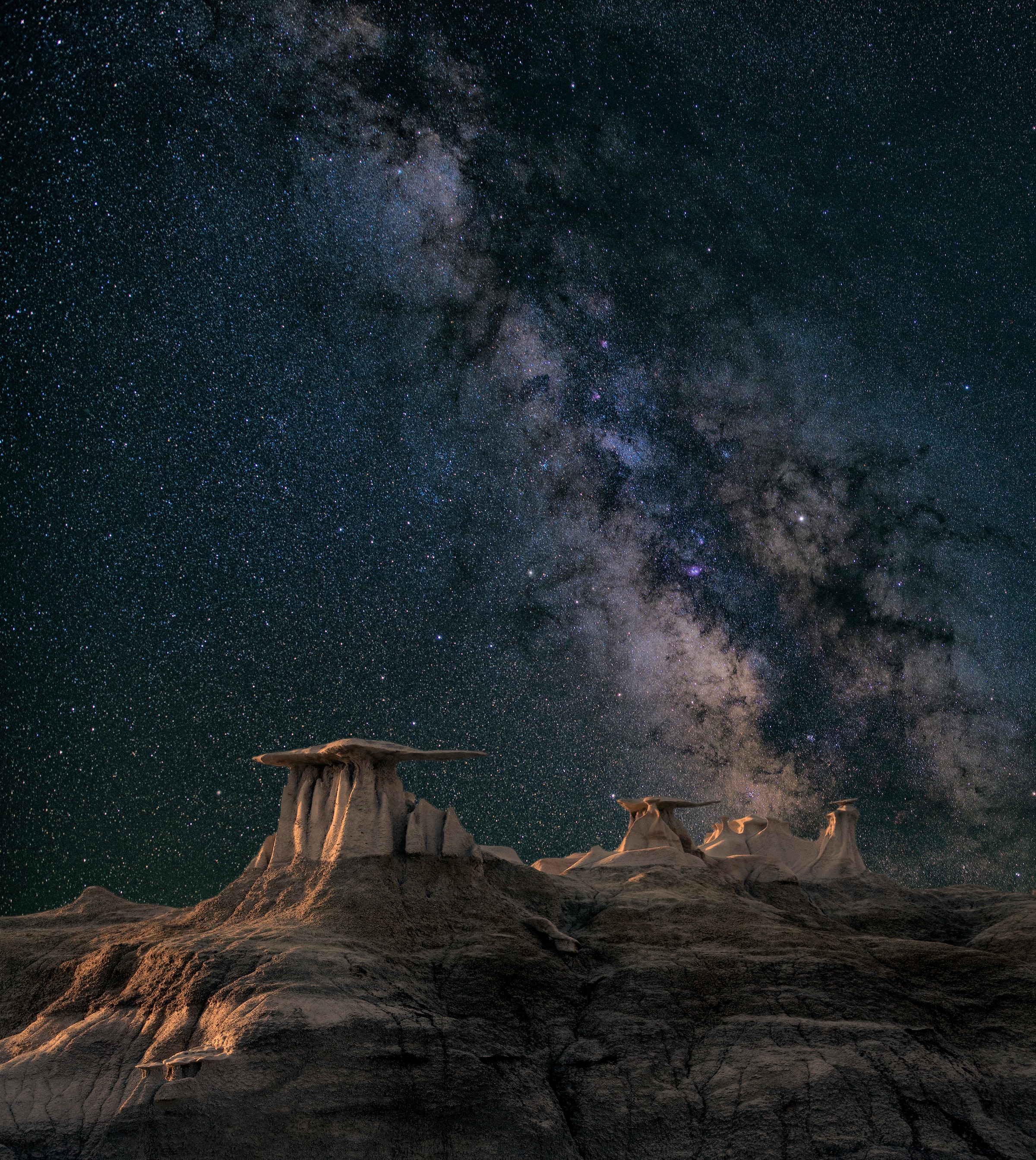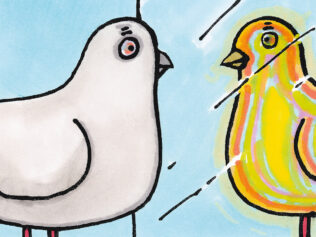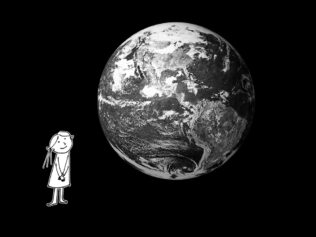
It’s best not to trust your eyes completely. They are easily deceived, particularly by the greatest swindler of all the colors—white.
A completely unremarkable hen’s egg, fresh from the fridge, beige-orange in color. Holding onto one end, I submerge the other in the smoky flame of a candle. The cold shell quickly cools the billowing orange flame, which emits a stream of soot. The surface of the egg is now covered with a thick, furry layer of charcoal. Beneath this layer, the egg disappears—because soot is the antithesis of light, almost perfect black. It is the only color humans can perceive that is actually the absence of color, the absence of light—essentially, nothing. I wait a moment for the egg to cool, then dip it into a glass of water. Magic! The pitch black disappears, the sooty tip of the egg now coated in a silvery, almost luminous white. A sudden transformation: from no light at all to total radiance. I remove the egg from the water and the tip is a blur of darkness again. The light seems to shun it. I dip it in the water—white again, not a trace of the murky void. The universe is teasing me.
Not that I would object to a temporarily cheeky, joke-loving universe—it might even be fun. But on this occasion, the explanation is more prosaic. In principle, there is nothing unusual happening here, no mysterious alchemy interfering with the eternal laws of physics. When it comes to color, one must be prepared for some degree of unpredictability. Human eyes—although often considered the pinnacle of evolution, the perfect organ—are far from perfect. It takes only a slight manipulation in the composition or texture of a viewed object, or its immersion in a different light than usual, for the precise machinery to suddenly fall apart. The eye does a great job at sending nerve signals, bundles of electric charge fired from the retina encoding the pure physics of the image being viewed. But our vision is governed not only by the eyes, but also—perhaps most importantly—by the brain, where this crystal-clear physical measurement is disassembled, and compared with previous experiences, expectations, and safe estimates of what should be happening. At the slightest unfamiliarity, the brain gives up—it stops understanding or, even worse, begins to fabricate reality. It sees movement where there is none; color where no drop of pigment has fallen; something where nothing ever existed.
Grades of Imperfection
Before the secret of the hen’s egg trick is revealed, let’s consider another equally confusing situation. Someone enters a red-lit room with two plastic balls in a bag. On removing them from the bag, their task is to recognize the balls’ color. Although the lighting conditions are not ideal, there is no doubt: both of them are a juicy cochineal. They hold the objects and step out into the sunlight. Impossible! One of them is indeed red, but the other is white as snow.
In both situations, the brain was teased by the color white, though differently each time. White, by the way, is a very interesting color. In fact, it is not even a color, but a combination of all the colors. Isaac Newton’s experiments confirmed that white light is actually the impression that is formed in the brain when the three color receptors in the eye are simultaneously stimulated by all colors of the spectrum—every single color of the rainbow. A white object appears white precisely because its surface—the material of which it is made or the paint covering it—reflects all the colors of light that fall on it. The soot-covered egg magically transforms into a silvery white due to the fact that its ability to reflect light is radically altered under water. In the glass of water, the greasy, hydrophobic soot is coated with a smooth “mirror,” with a thin layer of air underneath. Not only does the egg not get wet (after removal from the water, the sooty end is perfectly dry), but its light-absorbing blackness turns into a mirrored surface that reflects all light, all its colors. In the blink of an eye, black turns to white.
This totality of whiteness is also its curse. If even a fraction of one of its component colors disappears, the difference—the dissonance in its impeccability—is immediately noticeable. There are many different whites, and not one of them is actually perfect! Powdery gray “snow white,” slightly yellow “ivory,” pearly “cream,” grayish “alabaster,” unbleached “ecru”… Each of these colors could easily be classified as white, especially in comparison with most of the common colors: strong, saturated, with just a few components. Next to these shades, each of the aforementioned whites will be the same—“colorless”—and microscopic deviations from the ideal will not deprive them of their basic advantage: purity. It is only when compared to a truly, physically perfect white that the less perfect ones suddenly stand out. A pinch of yellow here, a snippet of dirty pink or barely perceptible blue there. In extreme cases—as in the hypothetical experiment with two balls—white, which is “accustomed” to being a universal reflector of any color, quickly reveals its non-selectivity. In red light, the white ball is indistinguishable from the red one—after all, both do the same thing in these conditions: they reflect the only available color of light. So the ball is not really white. Color is the impression that ultimately forms in the brain, consisting of everything from the properties of the viewed object to what the brain “decides” to see.
Vantablack & White 2.0
The irritating phenomenon by which “inferior” white seems to be a different color when compared to perfect white happens every day. White sneakers with a few years of wear suddenly become dirty gray, at best, when positioned next to a brand new, snow-white pair. Is there some kind of glass ceiling with these comparisons, a reference level that cannot be exceeded?
From a purely theoretical point of view, this would be the most perfect form of white—a color that reflects 100% of all visible radiation falling on a given object. Such a material would become both a benchmark for white and an invaluable engineering artifact. If the 100% ability to reflect radiation were to extend beyond the narrow part of the range of radiation registered by the human eye (called visible light)—for example, in the direction of infrared—the result would be objects that are not only visibly white, but also, for example, “infrared” white. They would reflect matter-heating infrared rays, constituting an extraordinary discovery in the fight against the constant overheating of structures built by humans.
As it turns out, however, this is hard to find. Although over the centuries, humans have used dozens of different white pigments, each one viewed at the time as the ultimate, “best” white (including toxic white lead—lead carbonate produced on the surface of lead bars fumigated with vinegar vapor—and zinc white, which is still added to strong sunscreens, not to mention the modern era of titanium white, which is blinding in its purity), at some point, an even more flawless white has invariably entered the scene, ruthlessly relegating all the previous varieties into the limbo of “dirty whites.” A breakthrough came in 2021 that has the potential to leave the competition behind for quite some time. Researchers at Purdue University produced “White 2.0,” a barium sulfate-based paint that, when applied to a surface, is able to reflect over 98% of the light that hits it. In full sun, a patch of this white barely heats up at all, effectively reflecting a large part of infrared radiation as well.
While 98% reflection may not look impressive compared to Spectralon’s 99.7%, it is still quite a feat. Spectralon, a fluoropolymer used to construct perfectly white items, has been considered the record holder in the field of whiteness for many years. In my job, I often have to measure the color of various objects; I use Spectralon as my point of reference. It reflects almost all the light that falls on it and thus constitutes a kind of “zero” on the “ruler” that measures other colors. Spectralon is so white as to be literally blinding in full sun. It does have a disadvantage, however: it is a material, a piece of plastic. It can be used to make an item, but not to paint a wall, while White 2.0 was made available in the form of acrylic paint shortly after its discovery. So it is worth sacrificing 1.7% of reflectivity for the convenience of applying the color with a brush.
When perfect white stormed the imagination of color specialists in April 2021, the internet was flooded with some rather strange comments. Less than a day after the discovery was announced, an appeal was made on The Verge: “[P]lease, researchers who are bringing us ultra-white paint, do not let Anish Kapoor get anywhere near it.” Kapoor is a British-Indian sculptor known for pieces such as Cloud Gate—a steel installation resembling a giant drop of mercury, located in Chicago’s Millennium Park. He is also famed as the creator of numerous works exploring darkness and lack of light, including his monumental “black holes” placed on gallery floors and walls. To enable his work, Kapoor reserved all rights to the use for artistic purposes of a material called Vantablack, which for a long time was the blackest man-made material. It is not a paint, but a special coating consisting of carbon nanotubes that can be sprayed onto various surfaces. This is a difficult process that requires special equipment. Kapoor’s uncompromising character (according to some, more like a combination of megalomania and egocentrism) and seeming desire to monopolize access to the very essence of a color earned him many enemies in the art world. The wars waged against him included the creation of the “pinkest” pink—a color with only one limitation of use specified by its inventor: it could not be used (or even purchased) by Kapoor. No wonder, then, that the imminent appearance of the most perfect white—the absolute opposite of Vantablack, and in the form of a convenient, efficient paint—immediately triggered a wave of comments and speculation.
Would Kapoor be determined enough to steal a second perfect color from the world in his quest to create the perfect artwork? According to my sources, as of the end of August 2022, White 2.0 is still a paint like (almost) any other: maybe not the cheapest, but certainly democratically available to anyone who is interested.
White Noise
It seems that humans put quite a lot of effort into finding extreme values. White and black are particularly appealing to the imagination, because while other colors can be graduated—the boundaries separating their variously perfect forms blurred—in these two cases, everything is unambiguous. Black and white, you might say. It turns out, however, that the search for the perfect white is not only the domain of human engineering, but also a much more deep-rooted activity, practiced by biological evolution through furnishing living organisms with white ornaments.
In nature, perfect white technically does not exist—and not just in the sense of the delicate border before which something is still white, and beyond which it becomes irreversibly “dirty” and tinted. Natural objects that we typically associate with white—clouds, snowdrifts, the crests of waves, fog—do not contain a single ounce of white pigment. They are all made of water, a substance that is almost completely transparent to light (especially in small amounts). The fact that clouds and snowballs are white is due to the chaos prevailing in these materials. The concept of “white noise” in physics and mathematics indicates a uniform chaos, a signal that is an uninterrupted stream of random units of information. The word “white” appears in this notion as somewhat of an analogy to the colorful totality of light. Just as white color is a combination of all possible colors of the rainbow, white noise is a combination of all possible levels of a signal. For example, when old analog TVs were set to a frequency outside the broadcast range of a given program, a swarm of random gray-white dots would appear on the screen, and a monotonous noise containing all possible sound frequencies would be emitted from the speaker. The whiteness of clouds or snow is also an expression of white noise, the chaos of ice crystals or water droplets. With no rules to organize their position, they surrender to complete randomness. And although the light reflecting off each of them could do something constructive, the assembly of billions of tiny reflections, random and scattered in a chaotic jumble, cancels out all signs of individuality, flattening the signal, leaving only neutral white.
Exactly the same strategy is used by living organisms to produce their whites. Daisies, Arctic hares, and seagulls do not produce white pigment in their tissues. Instead, the living matter of these organisms succumbs to chaos. The cells that build this matter grow chaotically, hair follicles and feather barbs filled with air bubbles that randomly solidify and reflect the light. Tissue that is by no means white—gray or fleshy beige at best—eventually fills with this pristine white.
This whiteness also has its own biological consequences. Since it does not depend on the production of any pigment, it is very unstable. It can be clouded by dirt or mechanical damage, which is either impossible to remedy (because, for example, a bird has to wait for a new feather to grow), or time-consuming and laborious to do so (because dirty whites have to be cleaned, wasting valuable resources). So it seems that the most inconspicuous of colors—some would even say a non-color—is a constant object of desire and cautious admiration. But one thing is still bothering me: how long until another discovery is made that bridges the gap between White 2.0 and 100% impossible white?

